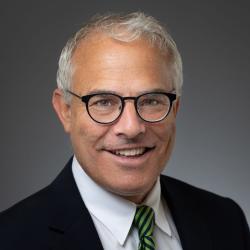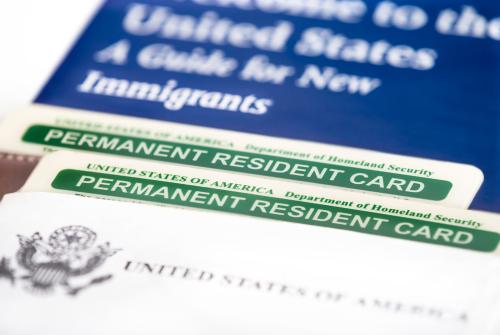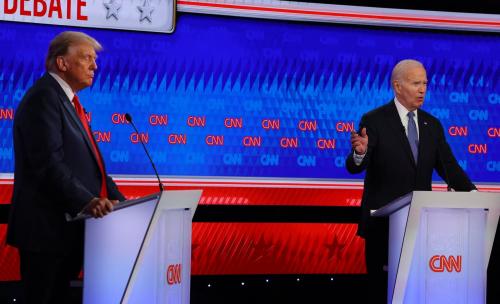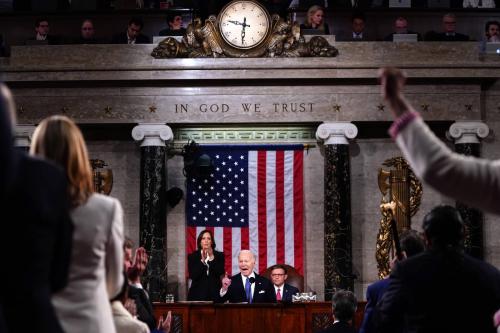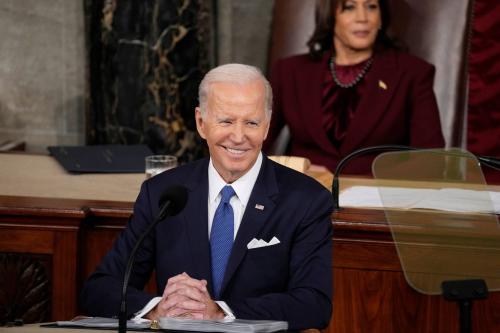The co-authors represent a range of attorneys and social scientists who have worked on the intersection of immigration and entrepreneurship, including the former USCIS Director Leon Rodriguez (to whom the 2014 memo was addressed). Co-authors Doug Rand and Lindsay Milliken are researchers at the Federation of American Scientists, focusing on the intersection of immigration policy and artificial intelligence (AI) in advancing the nation’s national security and economic growth. Co-author Kelli Duehning was the former USCIS Western Law Division Chief Counsel and participant in the development of the International Entrepreneur parole rule. And co-authors Berger, Yale-Loehr, Goldman, Serotte and Kludt are founders of the US Alliance for International Entrepreneurs, which advises entrepreneurs programs on university campuses.
In 2014, then-Secretary of the Department of Homeland Security (DHS) Jeh Johnson issued a memo (The 2014 memo) recommending “policies supporting U.S. high-skilled businesses and workers.” DHS offered a range of policies for updating the employment-based immigration system to encourage economic development. We propose that DHS issue a follow-up memo now focused specifically on international entrepreneurs to help the U.S. economy recover from the pandemic.
The 2014 memo was part of a broader series of executive actions on immigration issued during the last part of the Obama administration, after the Senate’s bipartisan comprehensive immigration reform bill foundered in the Republican-controlled House of Representatives. Congressional inertia across decades had left in place antiquated policies unsuited for a large and diverse country operating in a globalized economy. The U.S. was then and remains now at serious risk of competitive disadvantage compared to other developed countries that offer a more welcoming immigration system. As Doug Rand soon found as the first Assistant Director for Entrepreneurship in the Obama-era White House Office of Science and Technology Policy, “DHS has become the accidental regulator of global talent.”
The U.S. immigration system does not have a startup visa despite numerous attempts to create one in Congress.1 While a number of international treaties have temporary visas that can support investments, those treaties rely on a traditional mode of investment, such as the recipient of the visa investing “a substantial amount of capital” in a business in the United States. Start-up entrepreneurs, on the other hand, often do not have significant capital of their own to invest in an enterprise in the United States and are more often looking for investments themselves from venture capital or angel investors. Therefore, attorneys must consider creative uses of existing immigration categories to support international entrepreneurs.
A recent Brookings article by two of this report’s co-authors described ways that the Biden administration can improve employment-based immigration in general without new authorities from Congress. Also, a coalition letter has provided excellent suggestions, and the American Immigration Lawyers Association offers clear recommendations to boost efficiency. We take all these one step further to highlight ways to optimize current laws and regulations in support of international entrepreneurs. In particular, universities are crucibles of entrepreneurial energy, where incubators and accelerators allow research and business to blend into new companies. Our recommendations highlight the importance of encouraging entrepreneurial initiatives on U.S. campuses.
Media attention this year to the International Entrepreneur Parole Rule (IER) has led to a diverse coalition of organizations asking the Biden administration to support that program. On May 11, DHS withdrew a proposed regulation to rescind IER and the Biden administration announced it would revitalize the program. The IER was first finalized at the end of the Obama administration and authorizes the Secretary of Homeland Security to use his discretionary parole authority for temporary work permission for international entrepreneurs. Parole has historically been used for those seeking medical treatment in the United States, assisting U.S. communities after disasters, or cooperating with law enforcement. IER permits the DHS Secretary to offer parole for people who could provide a “significant public benefit” by starting businesses with high growth potential in the country. We strongly agree and suggest that DHS take this opportunity to issue a broader immigration agenda for international entrepreneurs to support job creation and economic recovery.
The 2014 memo – What is left to be done?
The 2014 memo laid out a variety of policy initiatives to support employment-based immigration, each of which directly or indirectly supports international entrepreneurs. Table 1 includes the recommendations from the 2014 memo and their current status, showing important accomplishments over the past seven years, and also some unfinished business.
| Recommendation | Status | Details |
| Coordinate with the State Department (DOS) to ensure all green cards (visas) are used each year.2 | Needs more work | There are still many unused immigrant visa numbers due to administrative errors each year. Unused visa numbers from previous years can be re-captured. |
| Allow job portability for those in the lengthy employment-based green card backlogs. Expand current policy to allow employees to file the final I-485 adjustment of status form based on DOS’ filing dates chart throughout the year to have benefit of work and travel permission given long green card backlogs. | Needs more work | This was done to some extent through regulations issued in 2016 but only applies to those at the end of the green card process.3 |
| Expand the list of academic fields eligible for additional Optional Practical Training (OPT) work authorization after a student graduates with a STEM degree. | Needs more work | Examples of fields to be added – Data Science (30.70) and Data Analytics (30.71), General Psychology (42.0101), Medicine (51.1201), Dentistry (51.04).4 |
| Foster cooperation among Immigration and Customs Enforcement (ICE), schools, and businesses to ensure OPT is working correctly as a training opportunity, in particular by reviving the Homeland Security Academic Advisory Council (HSAAC).5 | Needs more work | DHS published regulations in 2016 that allowed continued work while an application for STEM OPT is pending. More regular guidance and liaison between colleges/universities and ICE/DHS still needed. |
| Add guidance on how entrepreneurs could qualify for the relatively vague self-petition National Interest Waiver (NIW) green card category for entrepreneurs. | Completed | DHS did this through a precedent decision in 2016 by the Administration Appeals Office (AAO), which specifically noted the national benefit of entrepreneurial activity. DHS can continue to evaluate compliance with this case.6 |
| Create an International Entrepreneur program. | Needs more work | DHS did this at the end of the Obama administration with its discretionary parole authority, but it has been plagued by attempts to remove it. On May 10, the Biden administration announced that it would restart the program and market it to encourage entrepreneurs to apply. See more below. |
| Issue L-1B guidance to USCIS adjudicators on the definition of the “specialized knowledge” requirement for international transferees in this category | Completed | DHS issued a memo to this effect in 2015. |
Going beyond the 2014 memo – Recommendations for DHS to support entrepreneurs
In addition to the 2014 memo recommendations, we suggest DHS issue a new memo focused specifically on international entrepreneurs.7 We have organized our recommendations based on whether the ideas require formal notice and comment rulemaking.
Recommendations that do not require new regulations:
1. Bring back a dedicated entrepreneur portal on the U.S. Citizenship and Immigration Service website. (See here from the Wayback Machine, March 16, 2016). Support for international entrepreneurs will be amplified by a clear message and easy access to targeted guidance.
2. Strengthen the International Entrepreneur Parole Rule (IER) program. The IER was under attack since its creation at the end of the Obama administration. As of the writing of this article on May 10, 2021, the program has been revived by the Biden administration with the withdrawal of a proposed regulation to eliminate IER. We commend the Biden administration for prioritizing the innovation and economic growth from international entrepreneurs by revitalizing the rule. IER offers a compelling immigration pathway for entrepreneurs without the need for any congressional action and could create some one million U.S. jobs over 10 years.8 DHS should engage with the international entrepreneur community to ensure that those interested in starting businesses in the United States can take full advantage of the IER, issue new guidance for adjudicators to clarify evidentiary standards for investors, as well as issue guidance directing U.S. Citizenship and Immigration Services and U.S. Customs and Border Protection to grant beneficiaries the full 30-month initial parole period (except for extraordinary circumstances).
3. Issue clarifying guidance on the ability to engage in self-employment on STEM OPT extensions as long as there is a valid training plan and salary.9 In our experience as immigration lawyers/professionals, college and university international advisers hesitate to recommend STEM OPT for entrepreneurs despite the fact that some entrepreneurs receive adequate funding through university-based accelerator or incubator programs to provide the legally required mentorship training to qualify for STEM OPT. As such, international advisers should be allowed to recommend STEM OPT extensions for this population of entrepreneurs.
4. Expand the Premium Processing expedite service to include change of status and work card applications, and/or allow such applications to be processed through Premium Processing with the Principal Visa Holder’s petition (e.g., H-4 and work card with H-1B). Adding to the categories of premium processing takes advantage of authorization provided by Congress in late 2020 and will add much needed revenue for USCIS to engage in backlog reduction (since USCIS is a filing fee supported agency)—as much as $385-$626 million in additional revenue each year. USCIS used to process dependent applications as a courtesy, but that option was eliminated in 2019 because of required biometrics appointments for dependents.10 We support any option that will speed up applications for dependent status and associated work permits, as those types of employment authorization can be a valuable tool for entrepreneurial spouses.
5. Clarify that E-2 and L-2 spouses are authorized to work incident to status without waiting for an employment authorization document (EAD). There is mixed guidance on this issue. The Social Security Administration (SSA) policy and a Board of Immigration Appeals case support work authorization, as do 2006 liaison minutes between SSA and the American Immigration Lawyers Association.11 However, 2013 liaison minutes take an opposing view,12 and the federal E-Verify system does not permit work without an EAD.
6. Clarify appropriate use of Curricular Practical Training13 (CPT) for international students. Regulatory language needs to be changed to reflect the many ways that “practical training” happens in the current century. Some schools allow for broader use of CPT for entrepreneurial activities, while others remain restrictive in how they allow students to use CPT. The language in the regulations is not explicit in allowing for entrepreneurial activities, thus essentially leaving it up to schools to interpret.14For example, consider an MBA student who creates a social media startup, and develops it through an on-campus accelerator in her first semester. The school actively encourages entrepreneurial activity, but the student cannot run the company she helped start during the rest of the 2-year program. Most business schools will not offer CPT during the semester for internships, even though there could be an argument that they are an integral part of the curriculum. DHS should issue guidance that clarifies the use of CPT with specific attention to student entrepreneurs, and incorporate entrepreneurial examples into training modules. Many schools will not be comfortable authorizing CPT without a “safe harbor” provided in writing.
As examples, consider ways in which CPT has expanded beyond the 20th century model of doing a formal internship to gain experience:
- SCADPro: Companies bring their problems to the Savannah College of Art & Design (SCAD), which sets up teams of students who create solutions. This is not explicitly an internship, nor is it simply a class. It is students practicing what they have learned in the classroom in tandem with professors and companies. It is unclear whether unpaid experiences like this require CPT, and if it does, not all schools would agree to authorize CPT in this situation.
- San Jose State University: STEM professors from industry teach classes, some of which blend into real world problem solving within their company. This may not qualify as CPT if the class is labeled as an internship course.
- Art students who want to open an Etsy store to sell their products.
- Students who want to teach a class through Airbnb Experiences.
Overall, the current regulations do not support the diversity of academic and service-learning programs on campuses today. CPT can be a strong tool to give international students the same access to hands on learning experiences available to U.S. students, and spur entrepreneurial ventures. The original goal of employment restrictions for international students was to ensure that the primary purpose was education—that students were not spending most of their day delivering pizzas. However, academic and international advisers are in the best position to evaluate whether an employment opportunity meshes with the academic program. Similar arguments were used last year against a proposed regulation setting finite time limits on academic program completion. The academic and international advisers at a school can assess the value of an internship or job in the context of the program and the school’s educational mission.
Specifically, we recommend that amended regulations or guidance clarify that any internship or work experience required by any course for credit, or by any academic program and a prerequisite to completing all degree requirements, should be approvable as CPT, including between academic terms or off campus. The language regarding a “co-op” agreement should be eliminated or changed to remove the interpretation that all CPT must be under a written agreement between the employer and the institution. Last, we recommend clarifying that unpaid volunteer experiences do not require employment authorization. Currently, schools are restrictive on CPT, and pre-completion OPT often takes too long.
7. Revive the trusted employer program to eliminate the need to re-adjudicate the existence or operations of a particular employer or position
8. Provide clearer guidance on expedite criteria and create limited categories of blanket expedites to focus resources. Processing times can vary greatly, and many entrepreneurs contact USCIS to ask for expedites of work authorization or immigration status documents. In general, expedites are handled on a case by case basis. However, student entrepreneurs are often up against the clock with securing their OPT prior to their student status expiring as it takes time to set up their startups or obtain appropriate funding. Sometimes having a job starting soon would qualify for an expedite with USCIS as “severe financial loss,” and sometimes not.
For example, two of the co-authors supported blanket expedites for health care workers during the early days of the pandemic. That did not happen, but we estimate that over 95% of expedite requests for healthcare workers were granted. We submit that it would have been more efficient to create a blanket expedite for healthcare workers during the pandemic, which would have reduced the time officers spent on expedite requests and allow the officers to focus energy on case adjudication. Overall, we recommend consideration of a narrow category of expedites for entrepreneurs in targeted geographic areas or industries, additional guidance on expedite criteria to streamline review for those facing imminent expiration of their student visa, and consideration of limited categories of blanket expedites in very clear situations such as healthcare workers during the pandemic or startups that will also spur immediate job creation for US workers.15
Recommendations that require regulatory changes
1. Issue a regulation to add to the categories of employment authorization documents that benefit from the 180-day automatic extension while a timely application for renewal is pending. Currently, work authorization cards for spouses of H-1B, L-1 and E nonimmigrant status holders, as well as work cards for DACA recipients, are not automatically extended, and inconsistent processing times can lead to gaps in work authorization that can be detrimental particularly to an entrepreneur.
2. Issue a regulation to address OPT processing delays, such as granting conditional approval of employment authorization documents pending over 90 days, allowing students to start work on receipt of the OPT I-765 application receipt, or at least permitting students to apply for OPT six months ahead of time instead of five.
Conclusion
Looking back at the 2014 DHS memo, much has been achieved by that clear and incisive directive. We encourage DHS to issue a follow-up memo expanding on those earlier ideas, and adding guidance and policy specifically to support international entrepreneurs. The U.S. immigration system is a game of categories, and many of the categories were created at a time when most students were in class full-time and most workers were 9-5 employees. DHS guidance does not fully address situations encountered with the myriad of entrepreneurial ventures, university incubators, accelerators, campus-wide contests, etc. President Biden has issued an executive order that DHS should “identify any agency actions that fail to promote access to the legal immigration system.” DHS can do so, and take the opportunity now to support economic growth and job creation by providing clear guidelines for the appropriate use of existing immigration categories by entrepreneurs.
Leon Rodriguez is the former director of United States Citizenship and Immigration Services. Doug Rand is a senior fellow and Lindsay Milliken is a research assistant at the Federation of American Scientists, which is supported by Schmidt Futures. Rand is also Co-founder and advisor to Boundless Immigration Inc. Kelli Duehning was the former USCIS Western Law Division Chief Counsel and participant in the development of the International Entrepreneur parole rule. Dan Berger, Stephen Yale-Loehr, Jeff Goldman, Michael Serotte and Megan Kludt are founders of the U.S. Alliance for International Entrepreneurs, which advises entrepreneurs programs on university campuses. Other than the aforementioned, the authors did not receive financial support from any firm or person for this article or from any firm or person with a financial or political interest in this article. Other than the aforementioned, they are currently not an officer, director, or board member of any organization with an interest in this article.
-
Footnotes
- See, e.g., The Startup Visa Act of 2011, https://www.govtrack.us/congress/bills/112/s565, discussed at https://www.wsj.com/articles/SB10001424052748704694004576020001550357580. See also The EB Jobs Act of 2015, https://www.congress.gov/bill/114th-congress/house-bill/3370.
- There are two major categories of green cards, family-based and employment-based. If the Department of State predicts there will be surplus green cards in one category, that surplus is supposed to be added to the pot of green cards available for the other category. However, because the way the green card caps are calculated, surplus employment-based green cards are not counted when they are moved to the family-based category and are subsequently “lost.” This means that there are thousands of green cards that are not distributed each year, which exacerbates already lengthy green card backlogs.
- For a more detailed discussion of the negative effects of being tied to an employer during the green card process, see https://www.imdb.com/title/tt13609958/. We recommend DHS expand current policy to allow employees to file the final I-485 adjustment of status part of the green card process based on DOS’ filing dates chart throughout the year, to have benefit of work and travel permission if long green card backlogs. This is done month by month, but not as general policy.
- We also recommend using general field codes. The current list incentivizes schools to use subfields for their programs instead of the main fields, such 45.0603 Econometrics and Quantitative Economics, or even 51.2007 Pharmacoeconomics/Pharmaceutical Economics instead of 45.0601 Economics.
- HSAAC ended in September 2019 as a result of President Trump’s executive order to terminate one-third of federal agencies’ advisory committees.
- For a review of AAO National Interest Waiver cases in 2018, see https://millermayer.com/2018/entrepreneurship-in-the-national-interest-a-review-of-aao-national-interest-waiver-decisions-under-matter-of-dhanasar/
- Although the EB-5 Immigrant Investor Program is sometimes referred to as an “immigrant entrepreneur” program, in fact EB-5 is generally for passive investors, so is not discussed in this article.
- See generally these articles in support of a vibrant IER program – progressivepolicy.org, at fortune.com, and Wall Street Journal, and a coalition letter to DHS led by the National Venture Capital Association.
- See 2010 SEVP policy guidance – “Students on OPT may start a business and be self-employed. The student should be able to prove that he or she has the proper business licenses and is actively engaged in a business related to his or her degree program.” Also see these passages from the Federal Register that seem to accept the idea of employees who have an ownership interest in the business still qualifying for STEM OPT. 81 Fed Reg 13079 par. 517 and 523, and 81 Fed Reg 13072 par. 447; https://studyinthestates.dhs.gov/2016/09/reminder-stem-opt-students-must-train-bona-fide-employers ( DHS confirms that STEM OPT is available to founders of startups, but the founder may not sign his/her own Form I-983 Training Plan). Last, DHS website supports the use of STEM OPT by entrepreneurs in the STEM fields. https://studyinthestates.dhs.gov/2016/05/celebrate-small-business-week-and-learn-about-stem-opt-extension.
- USCIS announced recently in the course litigation that the biometrics requirement will be waived again for certain dependents. Edakunni v. Mayorkas, No. 21-cv-393-RAJ, US District Court for the Western District of Washington (Document 22, filed May 7, 2021).
-
See Minutes from AILA-SSA Liaison Meeting, AILA Doc. No. 06082360 (May 8, 2006) at https://www.aila.org/infonet/ssa-liaison-minutes-05-08-06 (accessible to AILA members).
On one occasion in 2014, an expedite request for an E-2 EAD was denied by USCIS explaining that: We contacted USCIS counsel and the adjudication unit and confirmed that an E-2 does not need to file an I-765. An E-2 can legally work in the U.S. “incident to status.” Some employers only feel comfortable if the employee has an EAD card, however and E-2 does not need an EAD card to legally work in the U.S. as long as they are in legal E-2 status.” (on file with co-author Dan Berger). - Q&As and Supplemental Notes from AILA’s Joint Meeting with USCIS Verification and ICE HSI (AILA Doc. No. 15020567, November 6, 2014), https://www.aila.org/infonet/uscis-verification-liaiston-minutes-11-06-14 (accessible to AILA members).
- 8 CFR 214.2(f)(10)(i) states that a student may participate in a “curricular practical training program” that is “an integral part of an established curriculum” and “directly related to the student’s major area of study.” The regulations also define curricular practical training as “alternate work/study, internship, cooperative education, or any other type of required internship or practicum which is offered by sponsoring employers through cooperative agreements with the school.” The regulation is not clear enough to provide adequate guidance for international student advisers on the wide variety of entrepreneurial situations on campuses today.
- The NAFSA Adviser’s Manual is a key legal reference for international student advisers. The Manual confirms that the existing guidance on CPT is not clear: The CPT regulations are brief, but dense, and subject to interpretation, especially on such issues as what constitutes enrollment during a period of CPT, and what constitutes an “integral part of an established curriculum.” … Since schools handle enrollment during internships and training programs very differently, it would be difficult to formulate detailed rules that would fit all situations. Some schools provide academic credit for training programs; others do not. This is an area of practice where advisers must exercise both discretion and caution. They must scrutinize each situation and decide whether or not it meets the requirements of the student’s program and the regulations. It is often helpful to involve the student’s academic department in the discussion about whether or not a training program meets the requirements of an individual student’s program, and to obtain a written recommendation from the academic adviser or dean that the student be authorized for the training in question.
- There is in practice a blanket expedite for some international adoption cases (I-600/I-800) as one example (although USCIS has declined to add I-130s for adopted children).
On one occasion in 2014, an expedite request for an E-2 EAD was denied by USCIS explaining that: We contacted USCIS counsel and the adjudication unit and confirmed that an E-2 does not need to file an I-765. An E-2 can legally work in the U.S. “incident to status.” Some employers only feel comfortable if the employee has an EAD card, however and E-2 does not need an EAD card to legally work in the U.S. as long as they are in legal E-2 status.” (on file with co-author Dan Berger).







